Greatstone Lakes
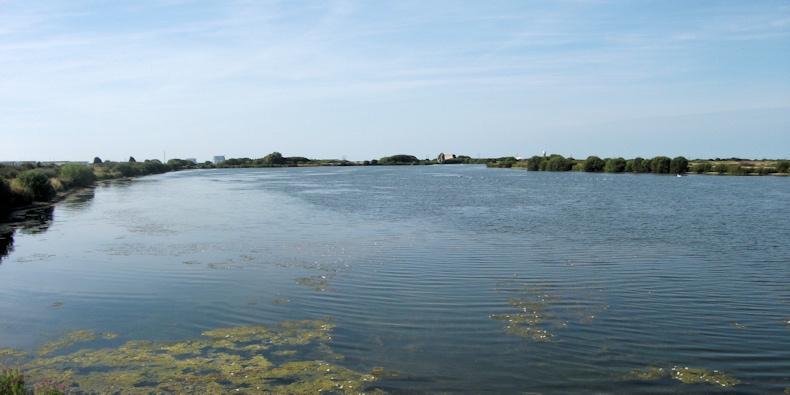
The North Lake
Greatstone Lakes are located in the Dungeness National Nature Reserve in Greatstone, to the west of the village. (see map, right). They are a haven for bird life and home to the Sound Mirrors, which are located on an island between the two lakes.
The two lakes, known as the north and south lakes, are man-made in so far as they are old gravel pits. In the 1970's the extraction of the gravel on the now nature reserve was an important industry, supplying gravel for sea defences and road building, amongst other things.
The lakes were formed by the extraction of a million tons of gravel over four years from an 89 acre site behind the holiday park.
(See 1974 Newspaper Article Re Objections to the Gravel Extraction)
The gravel was excavated and transported by a conveyer belt that used to run from the Sound Mirrors eastwards, going under the old Southern Region railway line to the road. The old bridge where the two lines crossed still exists today (2015).
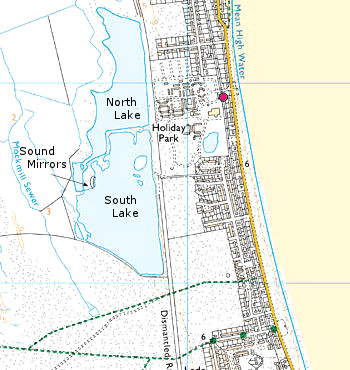
Map of Greatstone Lakes, with the Sound Mirrors
just visible on a small island between the two lakes

The South Lake
Wildlife
When the extraction ceased, the two large gravel pits were returned to nature and over time they have become two of the most beautiful water based habitats, covering an area of about 25 acres, for birds, other wildlife, fauna and flora.
The area around the lakes attracts walkers, bird watchers and wildlife enthusiasts alike.
Examples of the wildlife in the lakes are the famous Medicinal Leech, with the Greatstone Lakes being one of the best sites on the Romney Marsh, and hence in Britain, for this species.
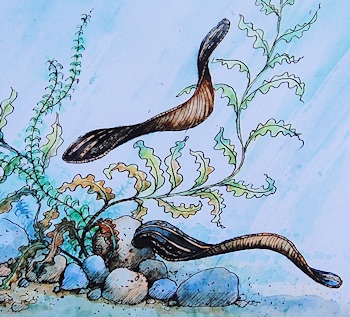
Medicinal Leeches
Birds in the winter include the smew, other ducks, divers and grebes, marsh harriers and bittern. Roosting waders from Greatstone Beach use the lakes. Birds in the summer include the marsh harrier, duck, swan and cuckoo.
The lakes are a very good site for the Marsh (Laughing) Frog. Originally from Hungary just 12 animals were introduced to a garden pond near Stone in Oxney in 1932 by Edward Percy Smith. This species then spread to all the corners of the Marsh where its characteristic croaking laugh frequently disturbs the sleep of many Marsh residents.
The Marsh frogs like to spend all their time in, or within jumping distance of, water. Both powerful swimmers and amazing jumpers, they often just stand in the mud, ready to leap into deep water at the first sign of trouble and landing with a resounding plop. They are robust and warty members of the green frog group, have a laughing call and a talent for singing whose quality is judged by females waiting to mate.
Fishing is not allowed on either of the two lakes.
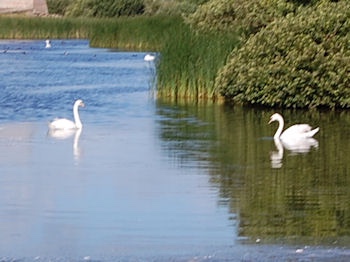
Swans on the South Lake
Sound Mirrors
The Sound Mirrors are three large concrete structures, built in the 1920s and 1930s, as part of an early warning system for Britain to detect enemy aircraft. The mirrors are situated on an island in between the two lakes.
The sound mirrors are private and only accessible on guided walks, (via the causeway), although they can be seen quite clearly from the east side of the larger lake.
See our Sound Mirrors page for more information.
Access to the Nature Reserve
There are two public footpaths providing access to the nature reserve. The first runs from near the south end of Leonard Road between two houses and the second from the west end of Taylor Road.
(See map above right; the public footpaths are the two dotted green lines running east and west below the lakes. See also Greatstone Map)
.jpg)
Sound Mirrors on the Lakes (ack.13)
Access to the reserve is also possible from the end of Coleville Crescent and Hull Road, both west off Leonard Road.
Walk almost west across the shingle and cross one of the two styles on to the what used to be the old railway track (see Greatstone on Sea Station). From here, the lakes are to the north (See Greatstone Map).
Alternatively, you can park in the car park in The Parade just past Hull Road, walk westwards down Taylor Road and then follow the signs for The Mirrors.
Further Information
For more information about the nature reserve and dunes, please visit the Dungeness National Nature Reserve and/or the Romney Marsh Countryside Project and/or the RSPB Reserve Dungeness websites.
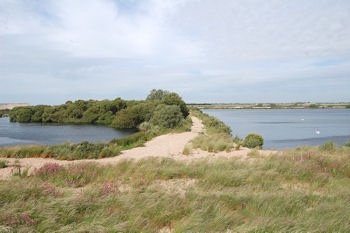
The Causeway, between the North and South Lakes


